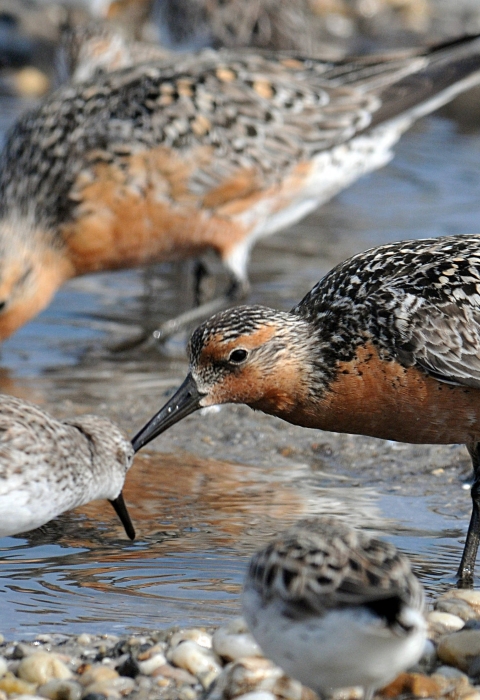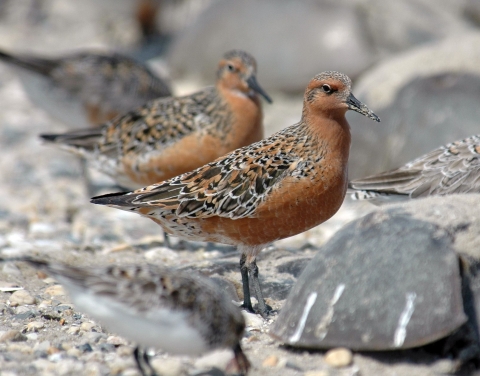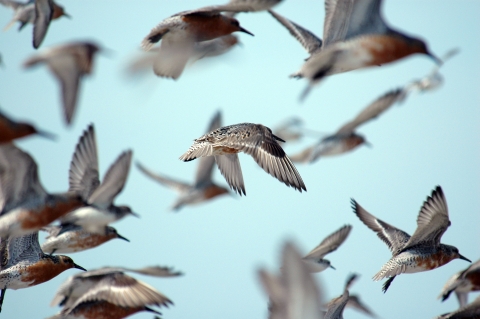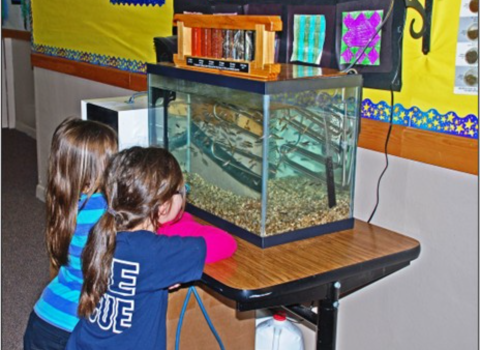Spring is a time to welcome the return of many migratory bird species and renew our efforts to conserve their habitats. While you might be familiar with long-standing initiatives to help species like the threatened piping plover, you might not realize many others benefit from a commitment to share the shore with wildlife.
The amazing rufa red knot is one of the beneficiaries of seashore conservation, and it’s important to understand why this species needs our help and how we can support it on its way.
Amazing Migration
The rufa red knot is nothing short of a migratory marvel. These birds are among the longest-distance migrants in the animal kingdom. Their range spans the entire western hemisphere, extending from the Arctic Circle to the southern tip of Argentina, and includes 40 states and 24 countries. During their spring and fall migrations, knots can fly as far as 9,300 miles each way!
Rufa red knots tend to winter in South America from December through February, although they could arrive in their wintering areas as early as September and leave as late as May for breeding grounds. They breed in the tundra of the Arctic Circle in June.
If you live along the East Coast of the U.S., you have the best chance of spotting a red knot during their spring and fall migrations. This April and May, keep an eye out at the beach for the distinctive “rufous” red plumage of these medium-sized shorebirds.
Threats
If you do catch sight of a red knot on its northern migration, you’ll also notice its scrawny appearance. When they show up on beaches in the spring in places like South Carolina, the Delaware Bay, and Long Island, they need to find enough sustenance to double their body weight for the last leg of their journey. Stopover points with adequate food resources are essential for successful migration.
The rufa red knot was listed as threatened in 2015 due to population declines linked to multiple threats and stressors that have impacted habitat and food supply across its vast range. Since the 1980s, the species' population has dropped by 75 percent in key wintering and stopover areas. The steepest declines have occurred since 2000, and the best estimates suggest the rufa red knot will be in danger of extinction in the foreseeable future.
Human disturbance is a major factor in these declines. Amazingly, individual birds tend to return to the same stopover sites along their extensive journeys because of the presence of nutrient-rich resources, such as horseshoe crab eggs, in those areas. Like your favorite restaurant, these places are hardly interchangeable. Human presence and development in these areas leave the birds with no place else to go.
Climate change is another major threat to the rufa red knot. Because their migration is so long, timing is critical for each leg of their trip. Changing habitat conditions in their breeding grounds can throw off their delicate schedule. Even slight variations in the timing of their migration due to shifts in seasonal changes can be catastrophic for the red knot’s chances at a successful trip.
Conservation Efforts
Fortunately, coordinated conservation efforts and individual actions can help the threatened knots on their way.
Climate change includes both global warming driven by human-induced emissions of greenhouse gases and the resulting large-scale shifts in weather patterns. Though there have been previous periods of climatic change, since the mid-20th century humans have had an unprecedented impact on Earth's climate system and caused change on a global scale.
Learn more about climate change are key to helping red knot populations soar. USFWS
Because their migration timeline is so tight and their stopovers so critical, knots need safe, dependable habitat to fuel up for each leg of their trip. On the U.S. East Coast, that means minimizing disturbance and development at the sites knots are known to visit.
Luckily, shoreline conservation efforts that protect other seashore species like the piping plover also benefit the rufa red knot. Just as you would do in areas where piping plovers are nesting, make sure to follow posted rules at beaches, clean up your trash, and keep pets leashed or indoors to prevent them from frightening or harming wildlife.
Doing your part to mitigate climate change also goes a long way in helping these long-distance athletes. By making small adjustments in personal energy use, reducing and reusing before recycling, and taking advantage of incentive programs for homeowners and renters to conserve energy, you can help many species affected by climate change — including people.
The Service collaborates with numerous partners across the rufa red knot's vast range to conserve and restore habitat, reduce disturbances from human activities, and expand what we know about this species through scientific research. But we need your help too.
We hope everyone will appreciate threatened species like the rufa red knot and do what they can to protect them. They are each one of a kind, and an irreplaceable part of our shared natural heritage.







